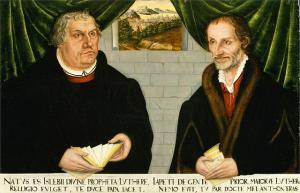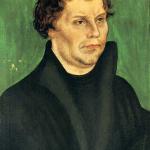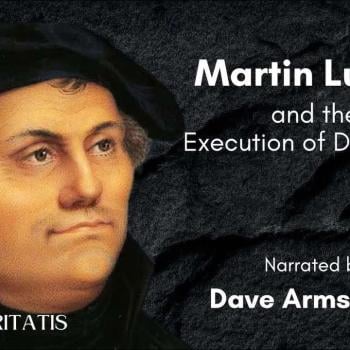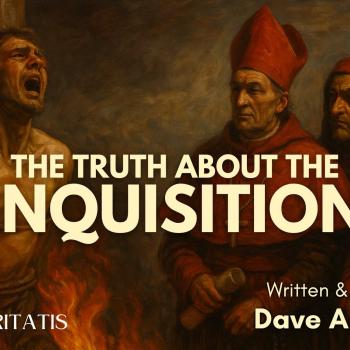Lucas Banzoli is a very active Brazilian anti-Catholic polemicist, who holds to basically a Seventh-Day Adventist theology, whereby there is no such thing as a soul that consciously exists outside of a body, and no hell (soul sleep and annihilationism). This leads him to a Christology which is deficient and heterodox in terms of Christ’s human nature after His death. He has a Master’s degree in theology, a degree and postgraduate work in history, a license in letters, and is a history teacher, author of 25 books, as well as blogmaster (but now inactive) for six blogs. He’s active on YouTube.
***
The words of Lucas Banzoli will be in blue. I used Google Translate to transfer his Portugese text into English.
*****
This is a reply to certain false claims in Lucas’ article, “Os protestantes perseguiram os anabatistas?” [Did Protestants persecute Anabaptists?] (8-17-18).
The general idea that Lucas defends in this article is that there were two very different strains of Anabaptists: radical and violent fanatics like Thomas Müntzer (c. 1489 – 1525) and peaceful Anabaptists, who simply wanted baptize adults, along with believing in several other deviations from traditional Catholicism and the recently begun “magisterial” Protestantism of Luther, Calvin, Zwingli, et al.
So far he says nothing untrue. It is his claim that Protestants executed only the radical fanatical Anabaptists that is absolutely false; and Lucas is smart and educated enough to certainly know this, or at the very least to do the minimal research necessary to discover it. Either he is very incompetent as a researcher of history, or (much worse) he is deliberately slanting what he presents (knowing it is untrue, or at best a half-truth), to further his agenda. Take your pick. But it must be one thing or the other, in light of the indisputable facts, as I will document them below. In charity, I prefer to assume that he is simply ultra-biased (as an anti-Catholic type of Protestant) and ignorant: leading to a wildly inaccurate, history-butchering presentation.
My research concerning the Protestant persecution of the Anabaptists involved mainly Martin Luther and his successor Philip Melanchthon, so I will concentrate on them only in this article. Since Luther was the founder of Protestantism itself, and of his sub-group of Lutheranism, obviously, he is a central and influential figure. If he believed in executing peaceful Anabaptists (which he did, as I will demonstrate), then Lucas’ claim that “Protestants” didn’t execute peaceful Anabaptists is false, because Luther and his group, the Lutherans, certainly did so.
[I]t is not right, and I truly grieve, that these miserable folk should be so lamentably murdered, burned, and tormented to death. We should allow everyone to believe what he wills. If his faith be false, he will be sufficiently punished in eternal hell-fire. Why then should we martyr these people . . . if . . . they are not guilty of rebellion or opposition to the government? . . . By fire we accomplish little. [Concerning Rebaptism, January 1528, in Luther’s Works [English], vol. 40, p. 230; I have modified Lucas’ text — translated from his Portugese to English — to agree with the English in this set; bolded emphases are Lucas’ own]
Luther was against executing people solely for religious beliefs , as the Roman Church did, but he was not against punishing those guilty of political rebellion against “divinely instituted” authority with the death penalty (Rom 13:2) , which was precisely the case with the radical Anabaptists of the Peasant Revolt that we studied earlier. In other words, the persecuted Anabaptists in Protestant countries were not persecuted for mere doctrinal divergence from some point of faith, but for rebellion and incitement to revolution, social disorder, anarchy, chaos.
This is a classic case study of Lucas’ highly selective bias. Luther did indeed believe the above, earlier in his revolt. But exactly two years and two months later (in March 1530), he changed his mind. If Lucas were attempting fair, objective, “all the relevant facts” history, he would have noted this, but he did not do so. Therefore, someone like me has to come along and inform readers of the whole, entire truth of the matter: rather than merely the half-truths of selecting what agrees with one’s own position and agenda in how to present Luther and Protestantism.
I think what I will demonstrate below is devastating to Lucas’ “historical credibility.” He’s feeding his readers anti-Catholic propaganda and not serious, scholarly historical information. He’s trying to whitewash controversial aspects of Protestant history and Luther that are difficult for present-day Protestants to “hear” and accept as historically documented facts. Lucas continues the falsehoods and half-truths throughout his article:
In relation to radical Anabaptists such as those of the Thomas Müntzer Rebellion and those of the Münster Revolution, both Protestants and Catholics were unanimous in their persecution. This was even advocated by the humanists of the time, such as Erasmus of Rotterdam, a “kind soul” who “desired the extermination of Anabaptists and other social extremists” [36] . But it was a persecution of a strictly political character, not of a religious nature. This is not surprising, as it was decreed for anyone who instigated an insurrection, often punishable by capital punishment anywhere in the world at the time.
That is why Walker writes that in Protestant territories the Anabaptists “were not treated as heretics, but as settlers” [37] , and still had the option of emigrating if they did not want to answer criminally for their actions [38] . The death penalty was only given to those who were considered “disturbers of the peace” [39] and who refused to emigrate, while “in Roman Catholic territories, mainly Austria and Bavaria, this law [the death penalty] was carried out with extreme severity” [40] . Lindberg agrees that the law “it was applied more forcefully in the (Catholic) Habsburg territories, while the evangelical territories and cities tended, in general, to apply lighter punishments, such as exile” [41] .
The more moderate Anabaptists had no more luck in Catholic lands: they were persecuted and burned in the same way, for the simple fact of being “heretics”, to whom the canon law of the Church demanded capital punishment. In contrast, in Protestant territories they were tolerated on a large scale, at least relatively. . . . [Walker] adds that the Anabaptists “were also active in Hesse and Saxony, the main Lutheran regions, and Philip of Hesse sought to treat them mildly” [43]. . . .
Another who granted tolerance to the Anabaptists was the reformer Martin Bucer in Strasbourg, where they were “treated generously” [48]. . . .
[U]nlike in Catholic lands, no Anabaptist was executed in a Protestant country for the simple “crime of heresy,” and even when an Anabaptist agitator was framed, the sentence was usually imprisonment or exile, not capital punishment. . . .
So yes, revolutionary and radical Anabaptists were persecuted, sometimes to death; and no, moderate Anabaptists were not persecuted by Protestants for purely religious reasons, although they had complications over political issues. [my bolding added; Lucas’ own italics]
This (particularly the bolded statements) is massively untrue, as I will now show. Protestant church historian Roland Bainton, who is most well-known for his biography of Martin Luther, Here I Stand (1950), which is the most famous and influential biography of Luther in English, verifies what I am contending. The following comes from his book, Studies on the Reformation (Boston: Beacon Press, 1963). I have highlighted the doctrinal / heretical aspects in green:
The outstanding reformers of the sixteenth century were in no sense tolerant. Luther in 1530 acquiesced in the death penalty for Anabaptists and Calvin instigated the execution of Servetus, while Melanchthon applauded. The reformers can be ranged on the side of liberty only if the younger Luther be pitted against the older or the left wing of the Reformation against the right . . .
By the beginning of March 1530 Luther gave his consent to the death penalty for Anabaptists, but on the ground that they were not only blasphemers, but highly seditious. . . .
Those who rush into the temple and blaspheme, should, on a second offense, receive the penalty of sedition. Here blasphemy seems to constitute the sedition. [BR, 1578 (June 1, 1530) ] In August he was pleased with the rumor of the execution of Campanus. [BR, 1672 (Aug. 3, 1530) ] In The Exposition of the Eighty-second Psalm in the same year blasphemy was put on a par with sedition. [WA, XXXI, 207] Nothing was said definitely as to the punishment, but death was almost certainly intended, for Luther had long recognized it as the current penalty for blasphemy. [WA, VI, 229. Cf. Volker, p. 91 and Paulus, p. 36, note 4] A direct appeal was made to the example of Moses, who commanded blasphemers to be stoned. [WA, XXXI, 209 (1530) ] Luther was no longer deterred because the Jews persecuted the true prophets. That was no reason for not stoning the false. [WA, XXXI, 213] The executioner should dispose of unauthorized preachers even though orthodox. [WA. XXXI, 212] It is not likely that the unorthodox would fare better, however authorized. . . .
Any doors which Luther might have left open in the second period from 1525 to 1530 were closed by Melanchthon in the memorandum of 1531. Rejection of the ministerial office was described as insufferable blasphemy, and destruction of the Church was considered sedition against the ecclesiastical order, punishable like other sedition. Luther added his assent,
for though it seems cruel to punish them with the sword, it is more cruel that they damn the ministry of the Word, have no certain teaching, and suppress the true, and thus upset society. [CR, IV, 739-740 (1531). Wappler, Inquisition, 61-62; Paulus, 41-43]
The second memorandum composed by Melanchthon and signed by Luther in 1536 is of extreme importance in making clear what was involved. The circumstance was that Philip of Hesse who steadfastly refused to go beyond banishment and imprisonment in matters of faith, invited the theologians in a number of localities to give him advice. One of the most severe among the replies was that which came from Wittenberg. In this document the Anabaptists were declared to be seditious and blasphemous, but in what did their sedition consist? The answer was: not by reason of armed revolution, but on the contrary, by reason of pacifism.
They teach that a Christian should not use a sword, should not serve as a magistrate, should not swear or hold property, may desert an unbelieving wife. These articles are seditions and the holders of them may be punished with the sword. We must pay no attention to their avowal ‘we did no one any harm’, because if they persuaded everybody there would be no government. If it be objected that the magistrate should not compel anyone to the faith the answer is that he punishes no one for his opinions in his heart, but only on account of the outward word and teaching. [Melanchthon]
The memorandum goes on to say that there were other tenets of the Anabaptists touching upon spiritual matters such as their teaching about infant baptism, original sin and illumination apart from God’s Word.
What now would happen if children were not baptized, if not that our whole society would become openly heathen? If then one holds only the articles in spiritual matters on infant baptism and original sin and unnecessary separation, because these articles are important, because it is a serious matter to cast children out of Christendom and to have two sets of people, the one baptized and the other unbaptized, because then the Anabaptists have some dreadful articles, we judge that in this case also the obstinate are to be put to death. [WA, L, 12] [Melanchthon]
Luther signed.
This document makes it perfectly plain that the Anabaptists were revolutionary, not in the sense of physical violence, but in the sense that their program entailed a complete reorientation of Church, state and society. For this they were to be put to death. (for further references and related material, see: Luther’s Attitudes on Religious Liberty [Roland H. Bainton] [2-16-06])
Bainton, in Here I Stand: A Life of Martin Luther (New York: Mentor, 1950, 295-296) noted what Luther wrote, in agreeing to the 1531 memorandum from Melanchthon:
I assent. Although it seems cruel to punish them with the sword, it is crueler that they condemn the ministry of the Word and have no well-grounded doctrine and suppress the true and in this way seek to subvert the civil order.
Here is a portion of the 1536 memorandum that Luther also gave assent to (doctrinal / heretical aspects again highlighted in green; my bolding also):
That seditious articles of doctrine should be punished with the sword needed no further proof. For the rest, the Anabaptists hold tenets relating to infant baptism, original sin, and inspiration which have no connection with the Word of God, and are indeed opposed to it. . . . Concerning such tenets, this is our answer : As the secular authorities are bound to control and punish open blasphemy, so they are also bound to restrain and punish avowedly false doctrine, irregular Church services and heresies in their own dominions; for this is commanded by God in the other commandment where He says : “Whoso dishonours God’s name shall not go unpunished.” Everybody is bound, according to his position and office, to prevent and check blasphemy, . . .
For think what disaster would ensue if children were not baptized; what would be the final outcome but thoroughly heathenish existence? Item, infant baptism rests on such sure foundations that the Anabaptists have no legitimate grounds for rejecting it. Item, if they say that children do not need forgiveness of sins, that there is no original sin, such statements are downright and very dangerous errors. Besides this the Anabaptists separate themselves from the churches, . . . they set up a ministry and congregation of their own, which is also contrary to the command of God. From all this it becomes clear that the secular authorities are bound to suppress blasphemy, false doctrine, and heresy, and to inflict corporal punishment on the offenders. . . .
[W]hen it is a case of only upholding some spiritual tenet, such as infant baptism, original sin, and unnecessary separation, then, because these articles are also important. . . we conclude that in these cases also the stubborn sectaries must be put to death. (cited in Johannes Janssen, History of the German People from the Close of the Middle Ages, 16 volumes, translated by A.M. Christie, St. Louis: B. Herder, 1910 [orig. 1891]; Vol. X, 222-223; my bolding)
For further related material, see: Luther Favored Death Penalty for Anabaptists [2-24-04]. If this weren’t enough to more than prove my contentions, I can present documentation of particular instances of such executions. I did so in my paper, Reply to Reformed Luther Apologist James Swan’s Request for Documentation of Executions of Anabaptists Sanctioned by Luther, in the 1530s [8-17-14]. Here are some excerpts:
I ran across . . . a work entitled, Valentin Weigel (1533-1588): German Religious Dissenter, Speculative Theorist, and Advocate of Tolerance (Albany: State University of New York Press, 2000), written by Andrew Weeks, who is a Professor of Languages, Literatures and Cultures at Illinois State University. He writes:
Of the various studies of Reformation-era intolerance, those of [Paul] Wappler and [Nikolaus] Paulus document conditions in Saxony . . . In Luther’s part of Saxony, there were executions for the offense of rebaptism as early as 1527 (before the imperial mandate of 1529), and afterward in the years 1530, 1532, and 1538. [60] Unlike the milder regime in Hessen, where as a rule only the openly rebellious dissenters were sentenced to death, the Wittenberg reformers soon came to support capital punishment even against peaceful heretics. [61] (p. 22)
There is evidence that as early as November 1529 Luther and Melanchthon sanctioned the death penalty for Anabaptists in an opinion to their Elector in response to the imperial mandate. [69] (p. 24)
By 1536, Luther, Bugenhagen, and Cruciger were advising Landgraf Philipp of Hessen to execute by the sword any Anabaptists apprehended in his territories. [74] Melanchthon was frankly encouraging capital punishment for heresy with or without rebellion. [75] (p. 25) . . .
The real “goldmine” of documentation in English comes from the same Encyclopedia [The Global Anabaptist Mennonite Encyclopedia Online], in its article on Saxony. It cites Wappler and Paulus as well, as two of its three sources from historians . . .
James Swan was unaware of all this. Now (if he can make it through this paper by a despised papist apologist) he is aware. He asked: “I’d like to know (or be reminded) exactly who Luther had executed in Wittenberg in the 1530’s.” The answer is in the above article, partially corroborated by historian Andrew Weeks in his book and drawn (in both cases) from the German historians Paul Wappler (Lutheran) and Nikolaus Paulus (Catholic). I’ll make it even more simple by the following list of Anabaptists executed in Saxony (incorporating information from further articles in this Encyclopedia about the Anabaptists involved):
1) “Beutelhans, Wolf Schominger (Schreiner), and ten other men besides a woman” were beheaded in the district of Königsberg, a Saxon enclave in Würzburg territory: March 1527. [13]
2) Six Anabaptists (Andreas and Katharina Kolb, Christoph Ortlep, Katharina König, Elsa Kuntz, and Barbara Unger) were imprisoned at Reinhardsbrunn and put to death on 18 January 1530. [6]
3) Berlet Schmidt, Hans Eisfart, and his wife, in the Hausbreitenbach district, which was under the joint jurisdiction of Saxony and Hesse; in 1532. [3]
4) Georg Köhler and an Anabaptist woman at Sangerhausen in the territory of Mühlhausen in September 1535. [2]
5) Hans Sturm of Steyer: 1535(?) or 1536(?) in Schweinitz near Wittenberg. [1]
6) Hans Peissker of Kleineutersdorf, after a minute cross-examination, attended by Melanchthon, was beheaded with Heinz Kraut and Jobst Möller in Jena on 26 January 1536. [3]
7) Heinrich Möller at Neustadt an der Orla, c. February 1536. [1]
8) Peter Pestel of Linz was beheaded on 16 June 1536 in Zwickau. [1]
9) Klaus Ernfart in 1536. [1]
10) Jakob Storger and Klaus Scharf besides eight women drowned in the Unstrut between Mühlhausen and Ammern on 8 November 1537. [10]
11) Hans Hentrock of Amra and Ottilia Goldschmidt, a Mühlhausen girl, drowned in the Unstrut between Mühlhausen and Ammern on 17 January 1538. [2]
12) Hans Köhler of Eyerode and Hans Scheffer of Hastungsfelde, at Eisenach, at the end of January 1538. [2]
By my reckoning, that is 45 people killed in Lutheran Saxony for the “seditious” crime of being an Anabaptist, between 1527 and 1538.
Swan would probably retort by saying that none of these seem to have been in Wittenberg itself. But that is an irrelevancy. They were carried out under Lutheran auspices, in Saxony: Luther’s home ground and the initial base of Lutheranism, with the direct assent and approval of Luther and Melanchthon. Where, specifically, the executions took place is entirely secondary to those considerations. . . .
The funniest thing of all . . . is [James Swan’s] attribution of Peter Pestel as the author or editor of The Global Anabaptist Mennonite Encyclopedia, when in fact, he is an Anabaptist martyr who was written about in that source (!!!). [this was in a Catholic Answers forum thread, on 3 September 2014 (comment #692) ]. . . .
Now, this may seem like my nitpicking or piling on, in a case of a simple mistake or human error. Readers may wonder why I am making such a “big deal” about it. I do precisely because Swan is always pointing out human errors in Catholic works (he’s noted real or — usually — falsely alleged — ones in my writings for twelve years). If a Catholic had made such an embarrassing error like this, we can be sure Swan would have trumpeted it from the rooftops as yet more evidence that we don’t know how to properly cite a source, and that we’re always trying to lie about and misrepresent Luther; that we’re, well, kind of dumb, and that we know nothing about context in reading and citing sources. He’s noted this many hundreds of times.
We know that Lucas draws from Swan. He did so, for example, in the article of his that I critiqued in my previous paper, “Did Luther Cause the 1525 Peasants’ Revolt? (vs. Banzoli)”. Yet Swan was so ignorant about Luther’s and Lutherans’ advocacy of execution of even (the vast majority of) peaceful Anabaptists — after 11 years of wrangling with me, over Luther’s life and beliefs and lying about me innumerable times — that he asked on the Catholic Answers Internet forum on 17 August 2014 (comment #347):
Nor do I recall Luther specifically having individuals executed in Wittenberg in the 1530’s. . . . I’d like to know (or be reminded) exactly who Luther had executed in Wittenberg in the 1530’s. While it certainly is within the realm of possibility that the secular authorities of Wittenberg during the 1530’s carried out capital punishment, I don’t recall this actually happening in the 1530’s, or more specifically, that Luther was involved with the carrying out of executions during the 1530’s, especially against Anabaptists.
I wrote my article, linked to above, on the same day, to provide him the proofs he was challenging Catholics to find. Needless to say, Swan ignored it (as he has almost all of my replies to him these past ten years or so; one can readily see why!). But his ignorant comments, made after at least eleven years of his own intense Luther research, stand for all to see, as a testament of his misinformation about Luther and capital punishment for heresy. Lucas Banzoli uses him as a reputable source. As we see, the shortcomings of anti-Catholic research are the same everywhere, so it’s no surprise to me at all to see Swan and his follower Banzoli spouting either ignorance or flat-out propagandistic inaccuracies about early Protestant history.
To be fair to Luther, I gladly note that later on in his life, Luther returned to his initial position of religious tolerance. Good for him. But we can’t blind ourselves to what he expressed from 1529 to at least 1540 or after. And this is why it is equal parts ridiculous and outrageous for Lucas to make the following patently false “universal negative” statements” (see above, in context):
[N]o Anabaptist was executed in a Protestant country for the simple “crime of heresy,” . . . moderate Anabaptists were not persecuted by Protestants for purely religious reasons, . . .
Besides Luther and Lutherans, I might mention in passing just two other examples that contradict Lucas’ silly universal negative denials. As the Scottish Whig historian Sir James Mackintosh noted in his Cabinet History of England: Scotland and Ireland, Volume 3 (1833): “John Weelmaker and Henry Toorwoort . . . two Anabaptists, were burnt at Smithfield [a district of London] on the 23d of July [1575]” (p. 170). This occurred during the reign of Queen Elizabeth I: very much a Protestant.
The Global Anabaptist Mennonite Encyclopedia Online (“England”) stated: “Members of the Austin Friars church, as well as the martyrologist John Foxe, interceded before the Queen and her Council in behalf of the imprisoned men, and Foxe obtained a reprieve to stay the execution for a month.” Generally speaking, and as another of the innumerable examples of Protestant intolerance, I have myself documented 312 Catholic Martyrs & Confessors Under “Good Queen Bess” (Queen Elizabeth: r. 1558-1603) [2-8-08].
“Reformer” Zwingli’s Zurich was also executing Anabaptists as early as 1527:
Zwingli’s personal attitude toward the increasingly repressive police measures taken by the authorities (prison February 1525; money fines and torture late 1525; death penalty and banishment decreed in 1526 and applied in 1527) has not been adequately studied. On the one hand he seems to have urged moderation and to have intervened personally in favor of some prisoners, yet at the same time he is reported to have preached that repression is the duty of a legitimate government; and in view of his dominant role in Zürich’s public life one can hardly conceive of these measures being taken against his will or without his approval. (The Global Anabaptist Mennonite Encyclopedia Online [“Zwingli, Ulrich (1484-1531)”] )
Certainly many many more such examples could be found: even in this one source by itself. Lucas simply doesn’t know what he is talking about, in deluding himself that Protestants never executed Anabaptists for heresy and what were regarded as false and dangerous beliefs. He himself (and anyone who believes in adult baptism today: as I once did myself: proven by my own adult “baptism” in 1982), could have possibly been executed for heresy in many Protestant regions in those days. As a Catholic, I would most likely not have been executed for heresy. This is actual Protestant history: not the squeaky-clean myths that are spouted for polemical, anti-Catholic purposes.
What Lucas claims about Brazilian Catholic apologists (whether real or self-proclaimed pretenders) in another paper (How a rogue Catholic apologist and hack blatantly lies to defame Luther, March 18, 2018), equally applies to his own efforts as a Protestant apologist and extreme anti-Catholic polemicist:
The hack wants to prove that Luther was an “evil immoral” and has no quote from Luther, just quote from a 20th century Catholic fanatic quoting what is said in another 20th century Catholic fanatic’s book. It is to this level of mediocrity that Brazilian Catholic apologetics has reached. And the worst thing is to see the lying liar still saying that these quotes are from “books of Luther or Lutherans”, trying to outwit the unwary. It’s not just mediocre: it’s disgusting. It is a veritable “anything goes” to attack Luther and defame the reformers in order to make the Roman Church look less monstrous than it actually is. It’s dishonesty after dishonesty.
To the Catholic apologist in question, I make a heartfelt plea: Assume you tried to fool your foolish readers and make a retraction video, taking that earlier crap off the air. It’s to try to save a modicum of dignity, if that sort of thing is still possible in this environment.
That works both ways, doesn’t it? I agree with his condemnation of fanatical anti-Luther apologetics. We must always speak the truth and document. But by the same token, anti-Catholic Protestant apologists (and even some non-objective, mediocre Protestant or secular historians) routinely try to whitewash and omit unsavory aspects of Luther’s teachings. Lucas did this above. I have corrected him, and so if he is honest and interested in seeking truth at all times, he, too, needs to retract the falsehoods he spewed in the article I am presently critiquing.
But he hasn’t responded at all to 14 articles of mine critiquing him (this is now the 15th), so what is the chance he will even read this paper, let alone honorably and honestly react by retracting his own falsehoods in presenting an inaccurate and incomplete, “half-truth” picture of Martin Luther to his readers?
***
Related Reading
Protestantism: Historic Persecution & Intolerance (Index Page)
***
Practical Matters: Perhaps some of my 4,000+ free online articles (the most comprehensive “one-stop” Catholic apologetics site) or fifty books have helped you (by God’s grace) to decide to become Catholic or to return to the Church, or better understand some doctrines and why we believe them.
Or you may believe my work is worthy to support for the purpose of apologetics and evangelism in general. If so, please seriously consider a much-needed financial contribution. I’m always in need of more funds: especially monthly support. “The laborer is worthy of his wages” (1 Tim 5:18, NKJV). 1 December 2021 was my 20th anniversary as a full-time Catholic apologist, and February 2022 marked the 25th anniversary of my blog.
PayPal donations are the easiest: just send to my email address: [email protected]. You’ll see the term “Catholic Used Book Service”, which is my old side-business. To learn about the different methods of contributing, including 100% tax deduction, etc., see my page: About Catholic Apologist Dave Armstrong / Donation Information. Thanks a million from the bottom of my heart!
***
Photo Credit: Double portrait of Martin Luther and Philipp Melanchthon, attributed to Lucas Cranach the Younger (1515-1586) [public domain / Wikimedia Commons]
***
Summary: Lucas Banzoli tries to argue that “no Anabaptist was executed in a Protestant country for the simple ‘crime of heresy'”. Wrong!: as I massively document with facts.














